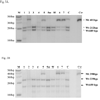The molecular basis of pyruvate carboxylase deficiency: mosaicism correlates with prolonged survival
- PMID: 18676167
- PMCID: PMC2572257
- DOI: 10.1016/j.ymgme.2008.06.006
The molecular basis of pyruvate carboxylase deficiency: mosaicism correlates with prolonged survival
Abstract
Pyruvate carboxylase (PC) deficiency (OMIM, 266150) is a rare autosomal recessive disease. The revised PC gene structure described in this report consists of 20 coding exons and four non-coding exons at the 5'-untranslated region (5'-UTR). The gene codes for three transcripts due to alternative splicing: variant 1 (NM_000920.3), variant 2 (NM_022172.2) and variant 3 (BC011617.2). PC deficiency is manifested by three clinical phenotypes-an infantile form (Type A), a neonatal form (Type B), and a benign form (Type C). We report the molecular basis for eight cases (one Type A, five Type B and two Type C) of PC deficiency. Eight novel complex mutations were identified representing different combinations of missense mutations, deletions, a splice site substitution and a nonsense mutation. The classical phenotypes (A, B and C) correlated poorly with clinical outcomes. Mosaicism was found in five cases (one Type A, three Type B and one Type C) and four of these cases had prolonged survival. Death in the fifth case resulted from unrelated medical complications. The discrepancy between the current findings and the existing classification system should be addressed to accommodate these new observations.
Figures




Similar articles
-
Structural insights on pathogenic effects of novel mutations causing pyruvate carboxylase deficiency.Hum Mutat. 2009 May;30(5):734-40. doi: 10.1002/humu.20908. Hum Mutat. 2009. PMID: 19306334
-
Intron retention and frameshift mutations result in severe pyruvate carboxylase deficiency in two male siblings.Hum Mutat. 2002 Jul;20(1):48-56. doi: 10.1002/humu.10093. Hum Mutat. 2002. PMID: 12112657
-
Pyruvate carboxylase deficiency type A and type C: Characterization of five novel pathogenic variants in PC and analysis of the genotype-phenotype correlation.Hum Mutat. 2019 Jun;40(6):816-827. doi: 10.1002/humu.23742. Epub 2019 Apr 13. Hum Mutat. 2019. PMID: 30870574
-
Pyruvate carboxylase deficiency: mechanisms, mimics and anaplerosis.Mol Genet Metab. 2010 Sep;101(1):9-17. doi: 10.1016/j.ymgme.2010.05.004. Epub 2010 Jun 9. Mol Genet Metab. 2010. PMID: 20598931 Review.
-
Disorders of pyruvate metabolism.Handb Clin Neurol. 2013;113:1667-73. doi: 10.1016/B978-0-444-59565-2.00034-4. Handb Clin Neurol. 2013. PMID: 23622387 Review.
Cited by
-
Pyruvate carboxylase deficiency type C; variable presentation and beneficial effect of triheptanoin.JIMD Rep. 2023 Dec 28;65(1):10-16. doi: 10.1002/jmd2.12405. eCollection 2024 Jan. JIMD Rep. 2023. PMID: 38186850 Free PMC article.
-
Case report of Takotsubo syndrome following seizures in a patient with pyruvate carboxylase deficiency.Eur Heart J Case Rep. 2021 Mar 4;5(3):ytab011. doi: 10.1093/ehjcr/ytab011. eCollection 2021 Mar. Eur Heart J Case Rep. 2021. PMID: 34109288 Free PMC article.
-
Pyruvate carboxylase and cancer progression.Cancer Metab. 2021 Apr 30;9(1):20. doi: 10.1186/s40170-021-00256-7. Cancer Metab. 2021. PMID: 33931119 Free PMC article. Review.
-
Regulation of pyruvate metabolism in metabolic-related diseases.Rev Endocr Metab Disord. 2014 Mar;15(1):99-110. doi: 10.1007/s11154-013-9284-2. Rev Endocr Metab Disord. 2014. PMID: 24214243 Review.
-
Perfiles clínicos, bioquímicos y moleculares de tres neonatos de Sri Lanka con déficit de piruvato carboxilasa.Adv Lab Med. 2024 May 15;5(2):213-220. doi: 10.1515/almed-2024-0021. eCollection 2024 Jun. Adv Lab Med. 2024. PMID: 38939210 Free PMC article. Spanish.
References
-
- Yoshida T, Tada K, Konno T, Arakawa T. Hyperalaninemia with pyruvicemia due to pyruvate carboxylase deficiency of the liver. Tohoku J Exp Med. 1969;99:121–128. - PubMed
-
- Atkin BM, Buist NR, Utter MF, Leiter AB, Banker BQ. Pyruvate carboxylase deficiency and lactic acidosis in a retarded child without Leigh's disease. Pediatr Res. 1979;13:109–116. - PubMed
-
- Gilbert EF, Arya S, Chun R. Leigh's necrotizing encephalopathy with pyruvate carboxylase deficiency. Arch Pathol Lab Med. 1983;107:162–166. - PubMed
-
- De Vivo DC, Haymond MW, Leckie MP, Bussmann YL, McDougal DB, Pagliara AS. The clinical and biochemical implications of pyruvate carboxylase deficiency. Journal of Clinical Endocrinology&Mrtabolism. 1977;45:1281–1296. - PubMed
Publication types
MeSH terms
Substances
Grants and funding
LinkOut - more resources
Full Text Sources

